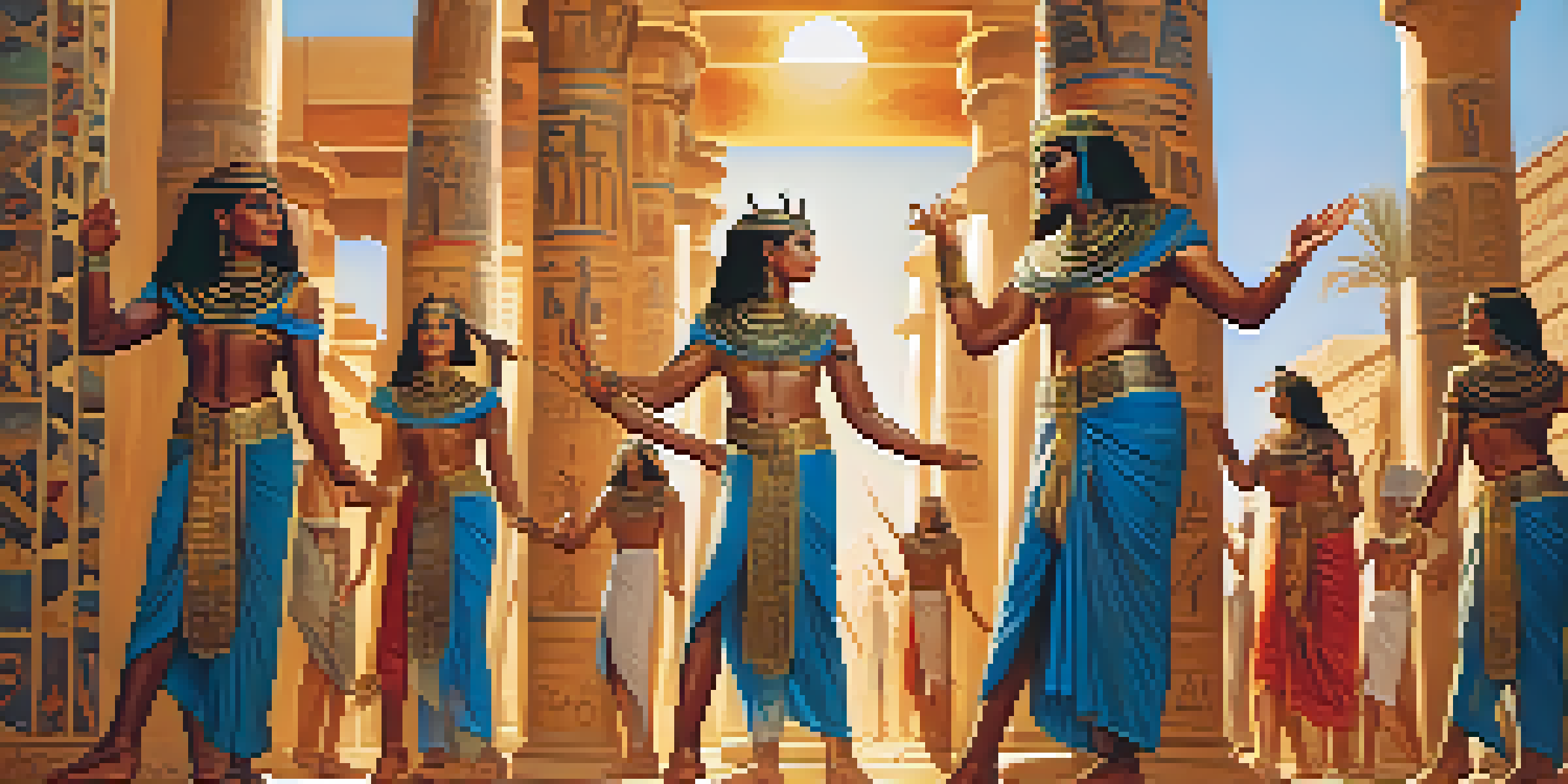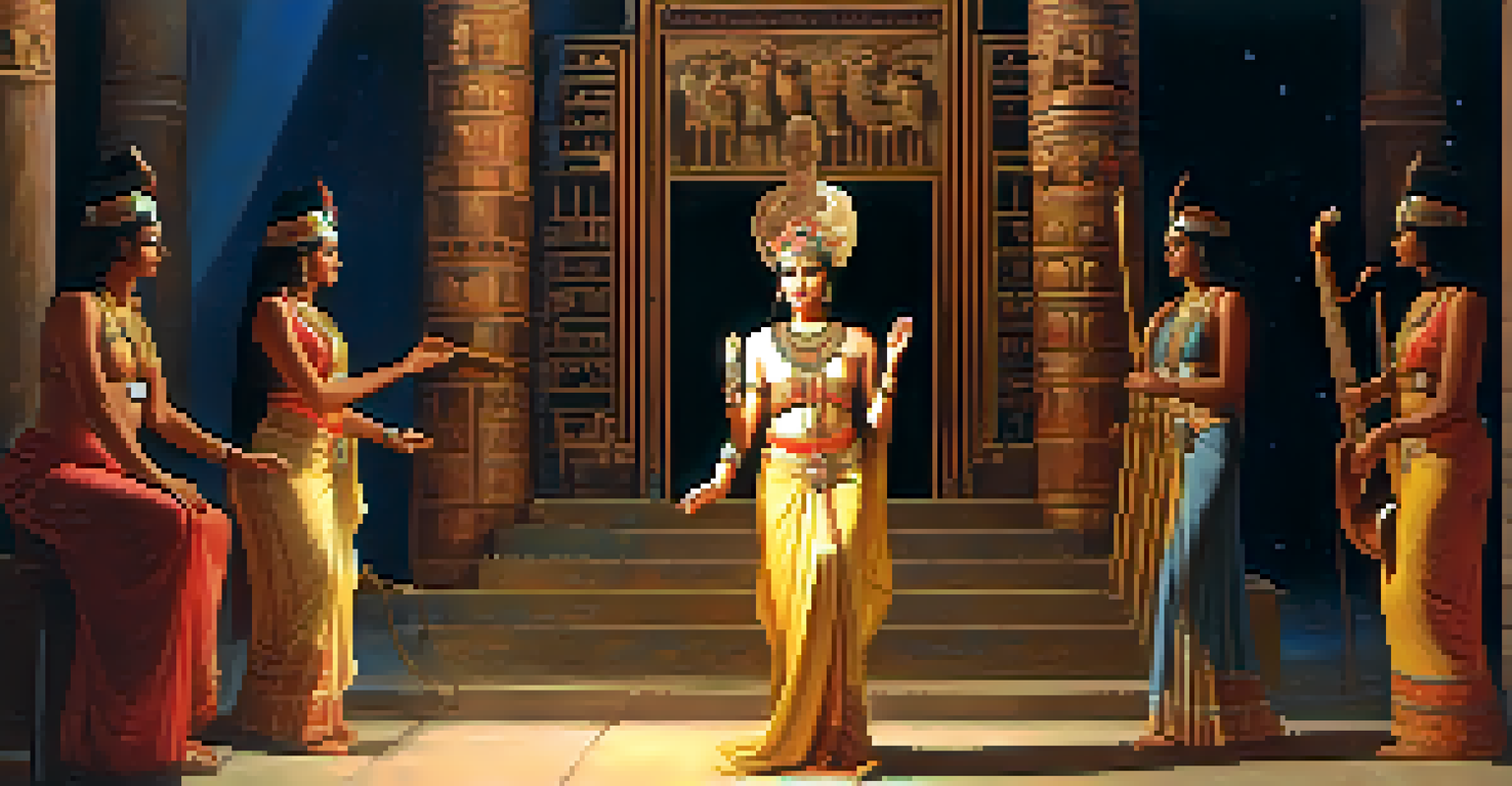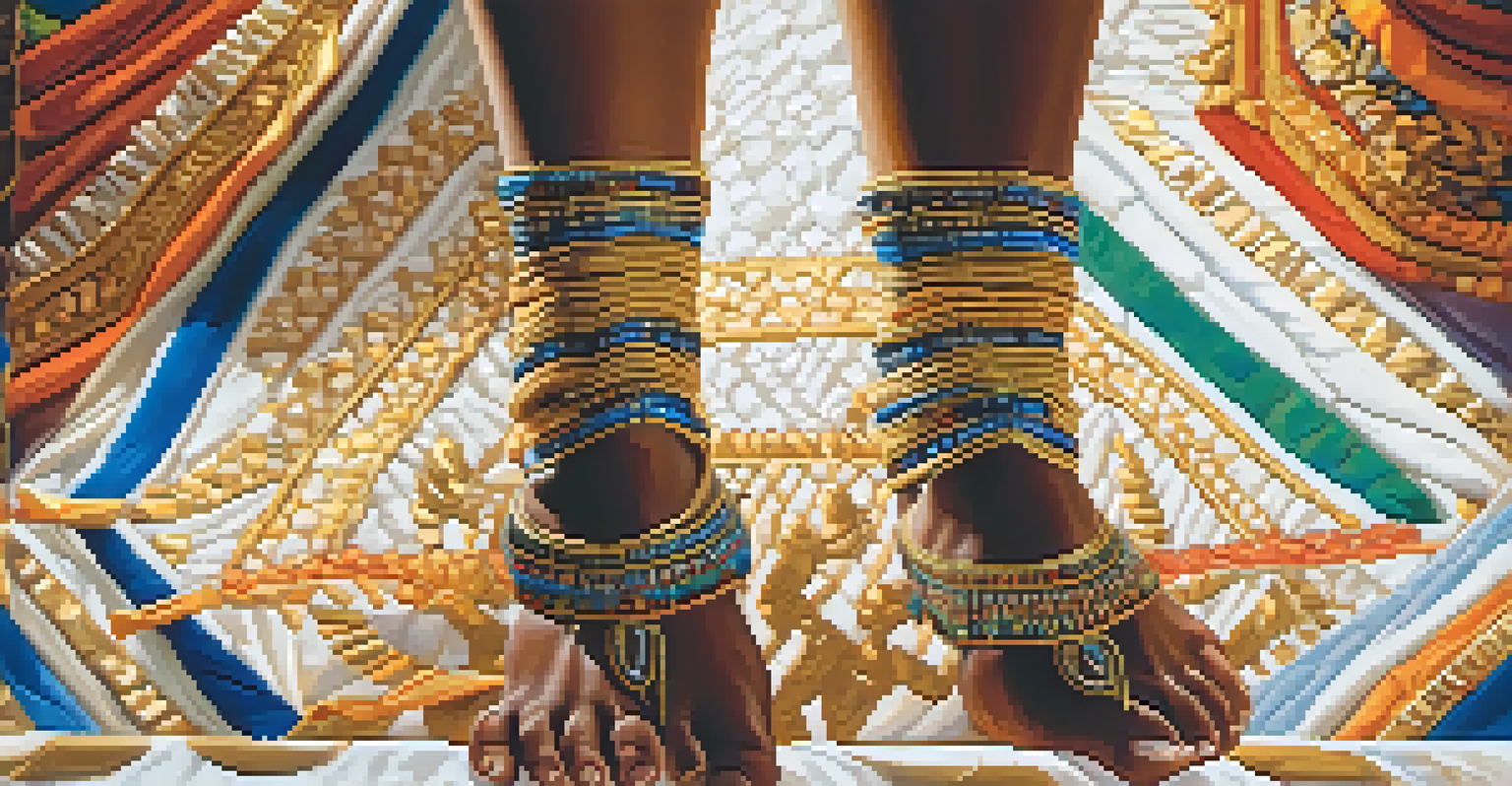Ritual Dance in Ancient Egypt: A Historical Perspective

Understanding Ritual Dance in Ancient Egypt
Ritual dance in Ancient Egypt was more than just entertainment; it was a profound expression of spirituality and cultural identity. These dances were often performed in temples and during religious ceremonies, serving as a way to honor the gods and connect with the divine. Each movement was carefully choreographed, reflecting the beliefs and values of the society at the time.
Dance is the hidden language of the soul.
The significance of these dances cannot be overstated. They were integral to worship and were believed to facilitate communication between the living and the gods. For example, dancers often portrayed deities, embodying their power and grace, which added a layer of reverence to the rituals.
Moreover, ritual dance was a communal activity that fostered a sense of belonging among participants and spectators alike. Whether performed during festivals or funerary rites, these dances reinforced social cohesion and cultural continuity, emphasizing their importance in Ancient Egyptian life.
The Role of Dance in Religious Practices
In Ancient Egypt, dance played a crucial role in religious practices, often intertwined with worship and offerings. It was common for priests and priestesses to perform dances as part of rituals aimed at pleasing the gods, ensuring their favor for the community. This connection between dance and devotion highlights the sacred nature of movement in their culture.

One notable example is the dance of the goddess Hathor, who represented joy, feminine love, and motherhood. Her followers would engage in lively dances that celebrated her virtues, creating an atmosphere of happiness and reverence. Such performances were not just rituals but also expressions of gratitude and celebration.
Dance as Spiritual Expression
Ritual dance in Ancient Egypt served as a profound expression of spirituality, connecting performers with the divine during religious ceremonies.
Additionally, dances often accompanied music and chanting, creating a multisensory experience that enhanced the spiritual atmosphere. The rhythmic movements, combined with the sounds of instruments like harps and flutes, transported participants to a higher state of consciousness, allowing them to feel closer to the divine.
Symbolism of Movement and Gesture
Every gesture and movement in Ancient Egyptian dance held symbolic meaning, reflecting the broader themes of life, death, and rebirth. For instance, movements that mimicked the flow of the Nile River symbolized fertility and abundance, while others might represent the cycle of life and the afterlife. This deep connection between movement and meaning enriched the cultural narrative of Ancient Egypt.
The body says what words cannot.
Dancers often used their bodies to tell stories, portraying myths and legends that were central to Egyptian beliefs. These performances served as a visual representation of their cosmology, making complex ideas accessible through movement. Audiences could witness the tales of gods and goddesses unfold before them, bridging the gap between the earthly and the divine.
Moreover, the use of specific colors and costumes added layers of symbolism to the dances. For example, the color white symbolized purity, while elaborate headdresses signified the dancer's status. This careful attention to detail ensured that every aspect of the performance contributed to its overall message and impact.
Incorporation of Music and Instruments
Music was a vital component of ritual dance in Ancient Egypt, enhancing the emotional and spiritual experience of the performances. Instruments such as lyres, flutes, and hand drums provided rhythmic accompaniment that inspired dancers and captivated audiences. The synergy between music and movement created an immersive atmosphere that deepened the ritual's significance.
The styles of music varied depending on the occasion, with faster tempos often used for celebratory dances and slower rhythms for more somber rituals. This variety allowed dancers to express a wide range of emotions, connecting the audience to the spiritual essence of the performance. Music, therefore, was not merely an accessory but an essential element that shaped the entire experience.
Symbolism in Movement
Every gesture in Ancient Egyptian dance was rich in symbolism, conveying complex themes of life, death, and cultural narratives.
Additionally, musicians and dancers often collaborated closely, with the music guiding the dancers' movements and vice versa. This dynamic relationship emphasized the communal nature of these rituals, as both performers worked together to create a harmonious expression of faith and culture.
Dance as a Reflection of Society
Ritual dance in Ancient Egypt served as a mirror reflecting the society's values, beliefs, and social structure. The themes depicted in dance often highlighted the importance of community, family, and the divine, showcasing how deeply intertwined these elements were in Egyptian life. In this way, dance became a vital tool for expressing collective identity.
For instance, the roles of dancers varied based on gender and social status, with professional dancers often enjoying a level of respect that transcended class barriers. Women, in particular, were celebrated for their roles in rituals, emphasizing their significance in both sacred and social contexts. This dynamic illustrates how dance was not only an art form but also a vital part of social commentary.
Furthermore, the evolution of dance styles over time mirrored changes in Egyptian society, from shifts in political power to transformations in religious beliefs. As the culture evolved, so too did the expressions found in dance, making it a living testament to the history of Ancient Egypt.
Legacy of Ancient Egyptian Ritual Dance
The legacy of ritual dance in Ancient Egypt continues to influence modern interpretations of dance and spirituality. Many contemporary dance forms draw inspiration from the movements and themes of ancient practices, highlighting the timelessness of this art. This connection allows us to appreciate the depth and complexity of ancient rituals in a new light.
Additionally, the study of these dances provides valuable insights into the cultural and religious life of Ancient Egypt. Archaeological findings, such as depictions in tombs and temples, offer glimpses into the significance of dance and its role in society. These discoveries help us understand how deeply rooted dance was in their worldview.
Legacy and Influence Today
The legacy of Ancient Egyptian ritual dance continues to inspire modern performances, highlighting its enduring relevance in expressing community and spirituality.
Modern performances that recreate ancient dances often aim to honor this rich history while also inviting audiences to engage with the themes of connection, spirituality, and community. As we explore these ancient practices, we keep the spirit of ritual dance alive, ensuring that it continues to resonate in our contemporary lives.
Conclusion: The Enduring Power of Dance
In conclusion, ritual dance in Ancient Egypt was a multifaceted practice that encompassed spirituality, community, and cultural identity. The importance of dance in religious rituals, its symbolic gestures, and the integration of music demonstrate how deeply ingrained this art form was in their society. It served as a powerful means of communication with the divine and a reflection of their values.
As we look back on this rich history, we can appreciate how dance continues to play a vital role in expressing human experience across cultures and time. The legacy of Ancient Egyptian ritual dance is not just about the past; it resonates with us today, inspiring modern interpretations and performances.

Ultimately, the enduring power of dance lies in its ability to connect us to our roots, transcend boundaries, and foster a sense of community. By honoring the traditions of the past, we keep the spirit of ritual dance alive, reminding ourselves of the beauty and significance of movement in our lives.